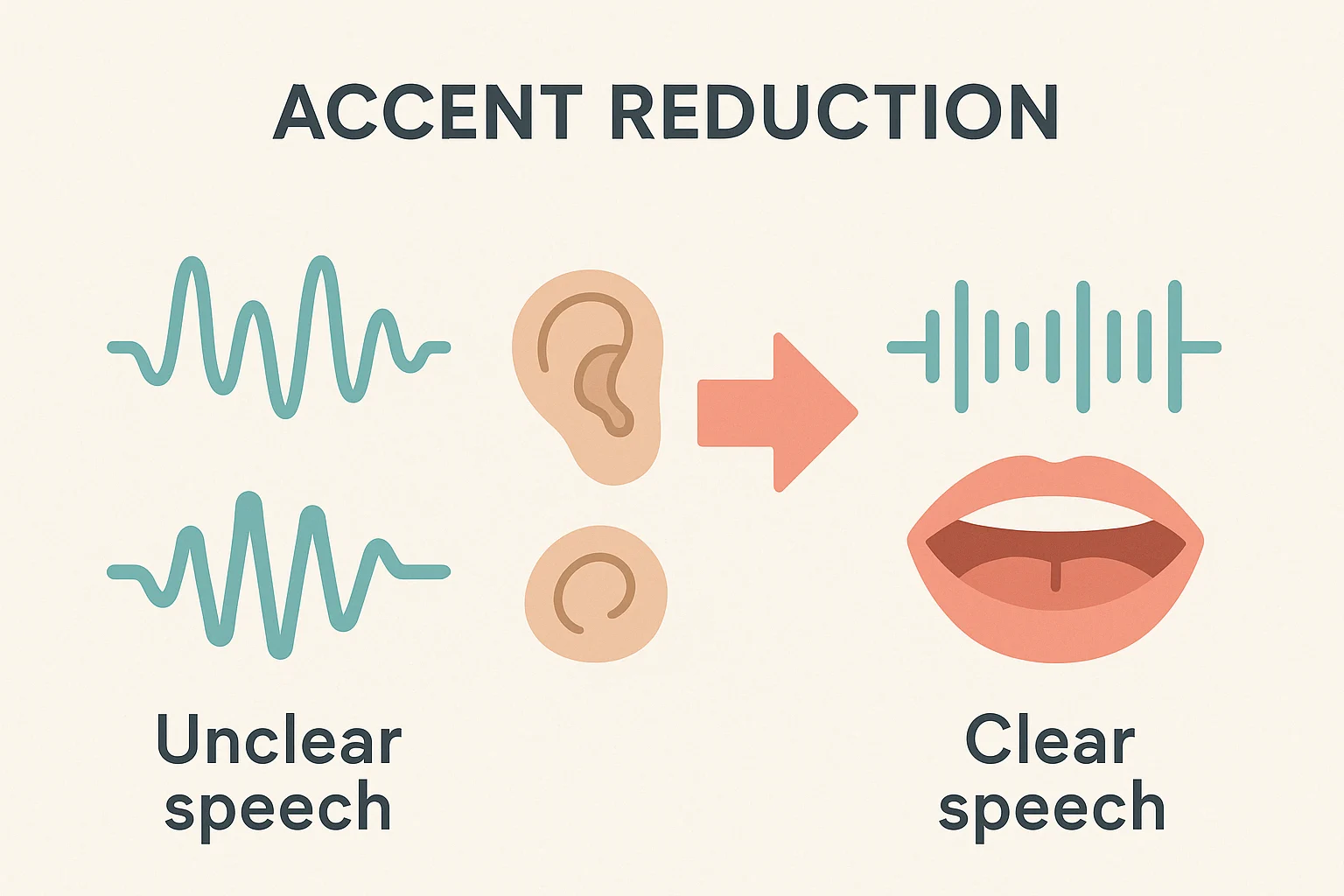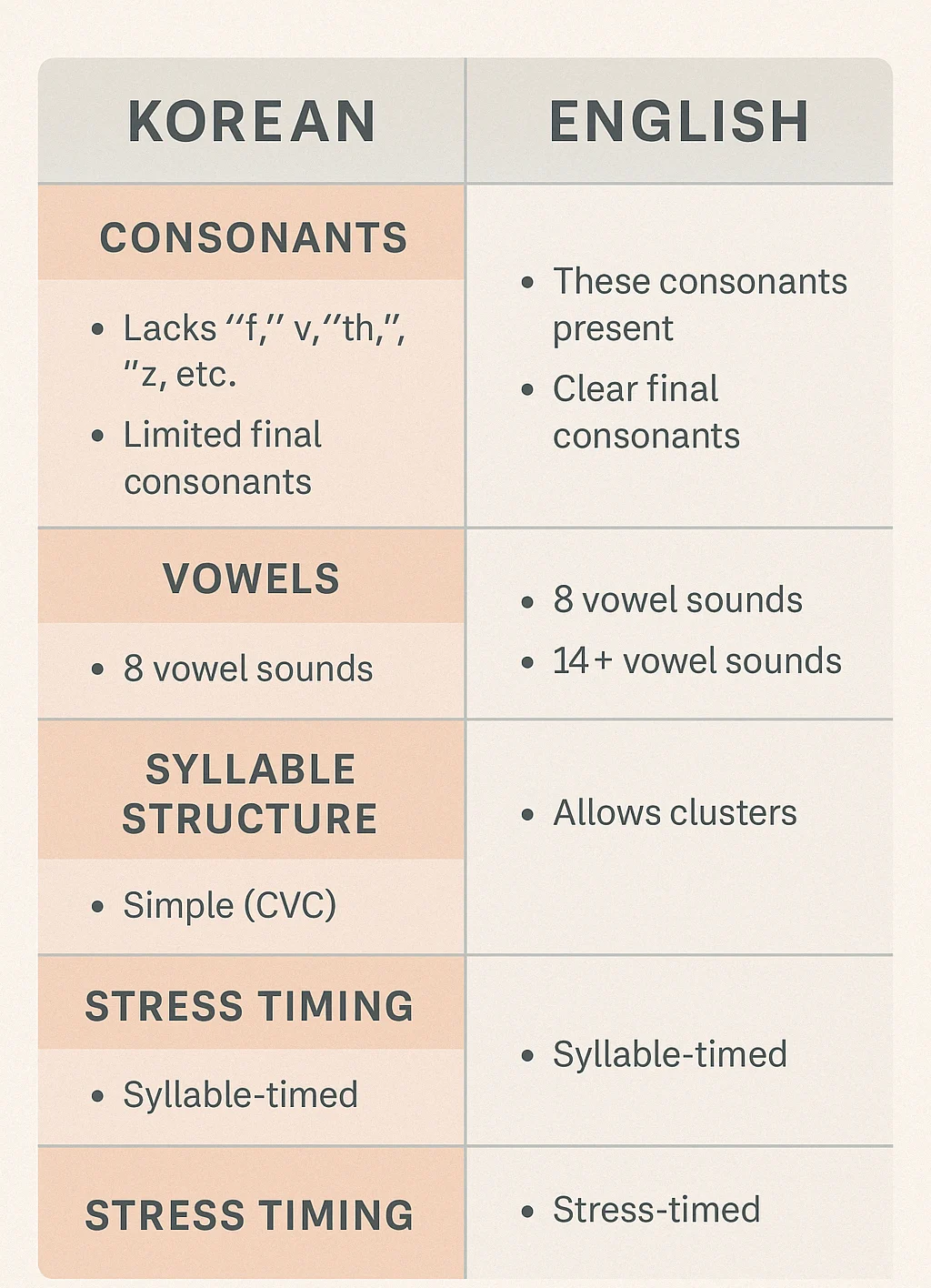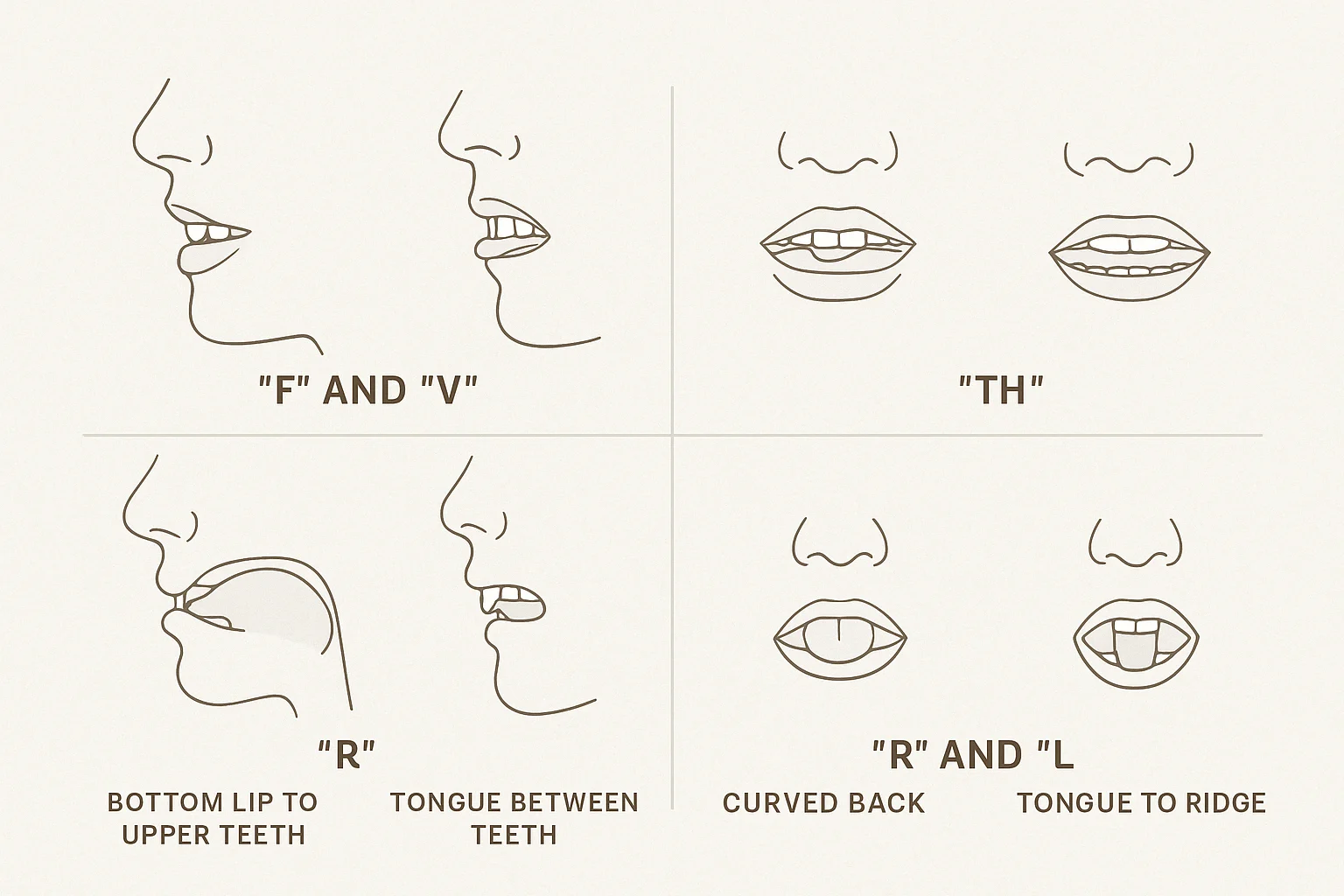How to Lose Korean Accent: A Complete Guide to Clearer English Communication

You’re proficient in English. You’ve mastered the grammar, built an impressive vocabulary, and can write eloquently. Yet when you speak, you find yourself repeating sentences, clarifying words, or noticing that subtle shift in your listener’s expression that tells you they’re working hard to understand.
I’ve worked with hundreds of Korean professionals facing this exact challenge. Many arrive at their first session feeling that their accent is holding them back from fully expressing their expertise and personality in English.
The good news? Accent reduction for Korean speakers is absolutely achievable with the right approach. In this guide, I’ll share proven techniques specifically designed to address the unique patterns that characterize a Korean accent in English, helping you communicate with greater clarity and confidence. Practice speaking regularly is crucial for accent reduction.
Engaging in conversation with native speakers and receiving feedback can significantly assist in reducing accents and building confidence. Consistent practice helps develop muscle memory, making it easier to adopt new sounds.

Introduction to Accent Reduction
Accent reduction is a process that involves modifying one’s speech patterns to more closely resemble the pronunciation of a native speaker in a target language. This can be a challenging but rewarding endeavor, as it can significantly improve communication skills and enhance overall language proficiency.
For language learners, reducing their foreign accent can be a key aspect of language learning, as it can help them to sound more like native speakers and be better understood. Effective accent reduction requires a combination of consistent practice, dedication, and the right techniques, including listening to and mimicking native speakers, practicing pronunciation, and seeking feedback from language tutors or speech therapists.

Understanding Korean-Accented English: The Foundation for Change
Before diving into techniques for Korean English accent reduction, it’s helpful to understand why certain English sounds and patterns are challenging for native Korean speakers.
Korean and English have fundamentally different phonological systems—different sound inventories, syllable structures, and rhythm patterns. These differences create predictable patterns in Korean-accented English that we can systematically address.
Language acquisition begins early in life, shaping speech habits and pronunciation patterns that influence the difficulty of adopting new sounds when learning a foreign language.
Key Differences Between Korean and English Sound Systems
Consonant Challenges:
- Korean lacks several English consonants, including “f,” “v,” “th” (both voiced as in “this” and unvoiced as in “think”), “z,” and the English “r” and “l” distinction
- Final consonants in Korean are limited and often unreleased, while English relies heavily on clear final consonants
Vowel Differences:
- Korean has 8 vowel sounds compared to 14+ in English
- Korean lacks many of the tense/lax vowel distinctions that exist in English (e.g., “sheet” vs. “shit”)
Syllable Structure:
- Korean syllables follow a strict consonant-vowel-consonant (CVC) pattern
- English allows complex consonant clusters (e.g., “strengths”)
Rhythm and Stress:
- Korean is a syllable-timed language where each syllable receives roughly equal emphasis
- English is stress-timed, with significant contrast between stressed and unstressed syllables
Understanding these structural differences in speech sounds explains why certain English sounds and patterns feel challenging—it’s not about ability but simply different linguistic programming.

Benefits of Accent Reduction
The benefits of accent reduction are numerous and can have a significant impact on both personal and professional life. By reducing their accent, language learners can improve their ability to communicate effectively with native speakers, which can lead to increased confidence and a sense of accomplishment. Accent reduction can also enhance career opportunities, as clear and effective communication is essential in many professional settings.
Additionally, reducing one’s accent can facilitate social interactions and help individuals to feel more comfortable and integrated into their target language community. Furthermore, accent reduction can also improve listening skills, as learners become more attuned to the subtle sound differences and pronunciation patterns of the target language.
Common Patterns in Korean-Accented English
When focusing on reducing accents for Korean speakers, these are the specific patterns that most frequently affect clarity:
Consonant Substitutions
Korean pattern: “F” becomes “p” (“pood” instead of “food”)
Clear English: Placing the lower lip against the upper teeth for “f”
Korean pattern: “V” becomes “b” (“berry” instead of “very”)
Clear English: Adding voice to the “f” position
Korean pattern: “Th” becomes “s” or “d” (“sink” instead of “think”)
Clear English: Placing the tongue between the teeth
The R/L Challenge
Korean pattern: Difficulty distinguishing between “r” and “l”
Clear English: Different tongue positions for each sound
Final Consonants
Korean pattern: Dropping or weakening final consonants (“boo” for “book”)
Clear English: Fully articulating word endings
Vowel Length and Quality
Korean pattern: Not distinguishing between short and long vowels
Clear English: Maintaining appropriate vowel length distinctions
Word Stress
Korean pattern: Equal emphasis on all syllables
Clear English: Stronger stress on key syllables with reduced unstressed vowels
Intonation Patterns
Korean pattern: Smaller pitch range, different question intonation
Clear English: Wider pitch range with specific patterns for questions vs. statements
By targeting these specific patterns, you’ll make rapid progress in your Korean accent reduction journey.
Understanding Language Variations
Language variations, including different accents and dialects, are a natural part of language use and can vary significantly from one region to another. Understanding these variations is essential for effective communication, as it can help language learners to recognize and produce the specific sounds, intonation patterns, and speech rhythms of their target language.
Language learners can utilize online resources, such as language learning apps and pronunciation guides, to learn about the different accents and dialects of their target language. By gaining an in-depth understanding of language variations, learners can develop a more authentic accent and improve their overall language skills.
The Role of First Language
The first language, also known as the native language, plays a significant role in language learning and accent reduction. The speech patterns, pronunciation, and intonation of the first language can influence the way language learners produce sounds and speak in their target language.
For example, non-native speakers may struggle to pronounce specific sounds or words that are not present in their native language. However, with consistent practice and dedication, language learners can overcome these challenges and develop a more native-like accent.
Language learners can work with a language tutor or speech therapist to identify areas where their first language is influencing their target language pronunciation and develop strategies to improve their accent.
A Step-by-Step Approach to Korean Accent Reduction
Now let’s explore a systematic approach to modifying these accent patterns:
Integrating correct pronunciation into your practice is crucial for effective accent reduction.
Step 1: Develop Your Ear Training
Before you can change your pronunciation, you need to train your ear to hear the differences between your current patterns and your target sounds, which is essential for identifying and correcting pronunciation errors.
Daily listening exercises:
- Listen to English podcasts, TED talks, or newscasts
- Pay attention to the rhythm and stress patterns of native speakers
- Focus on sounds that don’t exist in Korean (like “f,” “v,” “th”)
- Notice how words connect in fluent speech
Spend 10-15 minutes daily on focused listening. I recommend choosing a short audio clip (30-60 seconds) and listening to it repeatedly, gradually noticing more details each time.
Step 2: Master Physical Positioning for Challenging Sounds
Understanding the physical positioning of your articulators (tongue, lips, jaw) is crucial for Korean English accent reduction. Engaging in tongue twisters and articulation exercises can strengthen mouth muscles, aiding in the production of challenging sounds.
For the “F” and “V” sounds:
- Place your bottom lip lightly against your upper teeth
- For “f,” blow air through this narrow space
- For “v,” add voice while maintaining the same position
- Practice words like “fine,” “very,” “fifty,” “save”
For the “Th” sounds:
- Place the tip of your tongue between your teeth
- For unvoiced “th” (as in “think”), blow air gently
- For voiced “th” (as in “this”), add voice
- Practice words like “thank,” “these,” “both,” “breathe”
For the “R” sound:
- Pull your tongue back and curl it slightly upward
- Keep the sides of your tongue touching your upper teeth
- The tip should NOT touch any part of your mouth
- Practice words like “red,” “very,” “grow”
For the “L” sound:
- Place the tip of your tongue behind your upper teeth
- Allow air to flow around the sides of your tongue
- Practice words like “light,” “blue,” “cold”

Step 3: Practice Minimal Pairs
Minimal pairs—words that differ by just one sound—are powerful tools for accent reduction for Korean speakers and are an essential part of speaking practice:
R/L pairs:
- “right” vs. “light”
- “rice” vs. “lice”
- “grass” vs. “glass”
- “correct” vs. “collect”
F/P pairs:
- “fan” vs. “pan”
- “fine” vs. “pine”
- “safe” vs. “shape”
V/B pairs:
- “vest” vs. “best”
- “vote” vs. “boat”
- “have” vs. “hab”
Th/S pairs:
- “think” vs. “sink”
- “thin” vs. “sin”
- “path” vs. “pass”
Practice these pairs daily, recording yourself and listening for the distinctions. Work first on hearing the difference, then producing it consistently.
Step 4: Master Syllable Stress and Rhythm
After addressing individual sounds, focus on the rhythmic patterns of English:
Word stress exercises:
- Mark the stressed syllables in multi-syllabic words
- Exaggerate the stressed syllables and reduce the unstressed ones
- Practice word sets with different stress patterns:
- CONduct (noun) vs. conDUCT (verb)
- PREsent (noun) vs. preSENT (verb)
Sentence rhythm practice:
- Learn to identify content words (nouns, verbs, adjectives) vs. function words (articles, prepositions)
- Practice emphasizing content words while reducing function words
- Use rubber bands or hand movements to physically feel the stretching and compression of stress patterns
This step is often overlooked in Korean accent reduction, but it dramatically improves the natural flow of your English. Mastering syllable stress and rhythm can help learners sound more like a native English speaker.
Step 5: Practice Final Consonants
Since Korean limits final consonants, this area needs special attention:
- Practice words ending in consonants, particularly stops (p, b, t, d, k, g)
- Exaggerate the final sounds initially
- Use minimal pairs that contrast final consonants:
- “pick” vs. “pig”
- “hat” vs. “had”
- “back” vs. “bag”
Remember to fully release the consonant at the end rather than swallowing it. Developing pronunciation skills is crucial for mastering final consonants and achieving clearer English.
Step 6: Use the Record-Compare-Repeat Method
This technique is incredibly effective for Korean English accent reduction because it provides immediate feedback:
- Record a native speaker saying a short paragraph
- Record yourself saying the same paragraph
- Listen and compare the two recordings
- Identify specific differences in sounds, stress, and intonation
- Focus on one or two elements at a time
- Re-record yourself, incorporating the adjustments
- Compare again and continue refining
This method provides concrete feedback and helps you track your progress objectively.

Language Proficiency Assessments
Language proficiency assessments are an essential tool for evaluating language skills, including pronunciation and accent. These assessments can provide valuable insights into a language learner’s strengths and weaknesses, helping them to identify areas that require improvement.
Language learners can use language proficiency assessments to track their progress, set realistic goals, and develop a personalized plan for improving their accent and overall language skills. By utilizing resources such as language learning apps, pronunciation guides, and accent reduction classes, language learners can take significant strides towards improving their language proficiency and reducing their accent.
Regular practice, seeking feedback, and dedicated practice are essential for making progress in accent reduction and achieving a high level of language proficiency.
Practical Exercises for Daily Practice
Consistent daily practice is the key to successful accent reduction for Korean speakers. To achieve this, it is essential to practice regularly. Here are exercises you can incorporate into your routine:
Tongue Twisters for Problematic Sounds
For R/L distinction:
- “Red lorry, yellow lorry”
- “The little red robin ran around the rural road”
For F/V sounds:
- “Five very famous volleyball fans”
- “Vincent firmly fixed five fresh flowers”
For TH sounds:
- “These thirty-three thieves thought thoroughly”
- “They thanked their mother for the thick broth”
For Final Consonants:
- “Bob stopped at the red light and picked up Jack”
- “The big dog walked back to the correct spot”
Start slowly and gradually increase your speed while maintaining accuracy. These tongue twisters serve as interactive exercises that help learners mimic native speakers and improve their accents.
Shadowing Practice
Shadowing involves listening to native speech and repeating it with minimal delay:
- Choose audio with a speaker whose voice and pace you can reasonably match
- Listen to a short phrase
- Repeat it immediately, mimicking not just the words but the exact intonation and rhythm
- Gradually decrease the gap until you’re speaking almost simultaneously with the recording
This technique helps you internalize natural speech patterns while improving specific sounds. It also helps learners sound native by mimicking the exact intonation and rhythm of native speakers.

Real-Life Script Practice
Develop scripts for real life situations where clear communication is particularly important:
- Professional introductions
- Phone calls and video conferences
- Technical explanations related to your field
- Common social interactions
Practice these scripts until they feel natural, focusing on the specific sounds and patterns you’ve been working on.
How Long Does Korean Accent Reduction Take?
The timeline for reducing a Korean accent completely depends on several factors, but here’s what most of my Korean clients experience:
- First noticeable improvements: 2-4 weeks of consistent practice
- Significant reduction in misunderstandings: 2-3 months
- Comfortable, clearer pronunciation: 3-6 months
- Natural-sounding speech in various situations: 6-12 months
Factors that influence your timeline include:
- Your current English proficiency
- How many hours you speak English weekly
- Your daily practice consistency (the most crucial factor)
- The quality of your feedback
- Which specific patterns are most prominent in your speech
Remember that consistency is more important than intensity. Fifteen minutes of daily practice will yield better results than occasional marathon sessions.
Self-Practice vs. Working with a Coach
As you pursue Korean accent reduction, you’ll need to decide whether to use self-practice resources or work with a professional coach. Obtaining constructive feedback from native speakers and language tutors is crucial in this process, as it helps identify and correct pronunciation errors effectively.
Self-Practice Approach
Several self-study resources can help you make progress:
- YouTube channels focused on pronunciation
- Apps like ELSA Speak or Speechling
- Online courses targeting Korean accent patterns
- Mirror work with tutorial videos
Additionally, watching movies, TV shows, and videos in English can be a useful self-study resource for improving pronunciation and accent. Using subtitles can assist comprehension for those who are just starting to learn.
The DIY approach works best when you:
- Have a good ear for sound distinctions
- Can motivate yourself to practice consistently
- Are able to identify and correct your own pronunciation patterns
Benefits of Professional Coaching
Working with an accent coach offers several distinct advantages:
- Expert assessment of your specific speech patterns
- Real-time feedback before incorrect habits form
- Customized exercises targeting your unique challenges
- Accountability and structured progression
- Strategies for applying new patterns to real-world situations
Professional coaching also helps learners gain confidence in their language skills by providing personalized feedback and support.
Consider working with a coach if:
- You’ve tried self-study but hit a plateau
- You can’t hear certain sound distinctions
- You want to accelerate your progress
- You need accountability to maintain consistent practice
- You want a personalized approach tailored to your specific patterns
The most effective approach often combines initial coaching to establish correct patterns with self-practice between sessions.
Success Stories: Korean Professionals Who Transformed Their Communication
Let me share a few examples of how Korean speakers have successfully modified their accents:
Jin, Software Engineer: Jin struggled during team meetings, often finding his technical insights overlooked because colleagues had trouble understanding him. After focusing on consonant clarity and word stress for three months, he transformed his communication. “Now I can contribute fully in discussions,” he says. “My team implements my suggestions because they understand them the first time.”
Hyun, Financial Analyst: Hyun was hesitant to speak up during client calls despite her exceptional financial expertise. After working on the rhythm and intonation patterns of English, she developed a much clearer speaking style. “My confidence has completely changed,” she reports. “Clients focus on my analysis rather than struggling to understand my words.”
Soo-Jin, Medical Researcher: Soo-Jin worried that her accent was limiting her ability to present her research effectively at international conferences. After just eight weeks of focused work on problematic sounds and presentation intonation, she noticed a significant difference in audience engagement. “I no longer see that confused look during my talks,” she shares. “People ask about my research methods instead of asking me to repeat myself.”
These success stories demonstrate how targeted Korean accent reduction techniques can create meaningful improvements in a relatively short time.
Maintaining Your Identity While Reducing Your Accent
Many Korean speakers worry that modifying their accent somehow means sacrificing their cultural identity. This concern is completely understandable.
The truth is that accent modification is about adding communication options, not subtracting from your identity. Think of it like having different registers in your native language—formal speech for professional settings, casual speech with friends. You’re developing the ability to communicate more clearly in specific contexts while remaining authentically yourself. Developing a new accent can enhance communication without sacrificing cultural identity, allowing you to navigate different environments more effectively.
Many successful Korean professionals maintain their accent in personal settings while shifting to clearer pronunciation in professional contexts. This flexibility is a valuable skill, not a rejection of heritage.
You can absolutely maintain your unique voice and personality while making your pronunciation clearer. The goal isn’t to “erase” your Korean identity but to ensure your brilliant ideas are understood the first time.
Next Steps: Your Path to Clearer English Communication
Now that you understand the process for Korean accent reduction, here are the first steps you can take:
- Assess your current patterns: Record yourself speaking English and identify which patterns from this article are most prominent in your speech
- Train your ear: Spend 10-15 minutes daily listening to native English speakers, focusing on the elements that differ from your speech
- Practice physical positioning: Work on the tongue, lip, and jaw positions for challenging sounds like “r,” “l,” “f,” “v,” and “th”
- Focus on rhythm and stress: Practice emphasizing the correct syllables in words and using appropriate intonation in sentences
- Get expert guidance: Consider a professional assessment to identify your specific challenges and create a targeted plan
Remember that accent modification is a skill development process—like learning to play an instrument or mastering a sport. With consistent practice and the right guidance, you can dramatically improve your English pronunciation clarity while maintaining your authentic voice. Finding a language partner to practice with and receive feedback from can also significantly enhance your progress.
If you’re ready to take the next step in your Korean English accent reduction journey, I offer personalized assessments to identify exactly which aspects of your speech would benefit most from modification, along with a customized plan designed specifically for Korean speakers.
Schedule Your Free Accent Assessment Today!

Frequently Asked Questions About Korean Accent Reduction
Is it possible to completely eliminate my Korean accent?
While complete accent elimination is uncommon, you can certainly reduce it to the point where it no longer creates communication barriers. Most Korean speakers can develop pronunciation that is easily understood by native English speakers with a few months of focused practice. Rather than aiming for “no accent,” focus on clear communication as your goal.
What’s the most challenging English sound for Korean speakers?
While individual challenges vary, most Korean speakers find the “r/l” distinction, the “f/v” sounds, and the “th” sounds (both voiced and unvoiced) most challenging. The rhythm and stress patterns of English also present significant difficulties since they differ fundamentally from Korean.
Does age affect my ability to reduce my accent?
While children typically acquire new sounds more easily, adults of all ages can make significant improvements in their pronunciation. I’ve worked with Korean professionals in their 50s and 60s who have successfully reduced their accents. Neuroplasticity continues throughout life, allowing you to form new speech habits at any age.
Should I learn American or British English pronunciation?
Choose the variety you’ll use most often in your daily life or professional context. If you work primarily with Americans or plan to live in the US, focus on American pronunciation. If you interact mostly with British English speakers, prioritize those patterns. The key is consistency—mixing the two can create confusion.
How can I practice if I don’t have many opportunities to speak English?
Create practice opportunities even when you’re alone:
- Read aloud for 10-15 minutes daily
- Have conversations with yourself about your day
- Record and listen to yourself
- Join online language exchange communities
- Find a conversation partner through apps like Tandem or HelloTalk
- Participate in virtual meetups for English practice
Even without regular conversation partners, consistent solo practice can lead to significant improvements in your Korean accent reduction journey.

